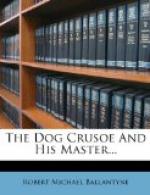In excursions of this kind it is customary to “hobble” the horses—that is, to tie their fore-legs together, so that they cannot run either fast or far, but are free enough to amble about with a clumsy sort of hop in search of food. This is deemed a sufficient check on their tendency to roam, although some of the knowing horses sometimes learn to hop so fast with their hobbles as to give their owners much trouble to recapture them. But when out in the prairies where Indians are known or supposed to be in the neighbourhood, the horses are picketed by means of a pin or stake attached to the ends of their long lariats, as well as hobbled; for Indians deem it no disgrace to steal or tell lies, though they think it disgraceful to be found out in doing either. And so expert are these dark-skinned natives of the western prairies, that they will creep into the midst of an enemy’s camp, cut the lariats and hobbles of several horses, spring suddenly on their backs, and gallop away.
They not only steal from white men, but tribes that are at enmity steal from each other, and the boldness with which they do this is most remarkable. When Indians are travelling in a country where enemies are prowling, they guard their camps at night with jealous care. The horses in particular are both hobbled and picketed, and sentries are posted all round the camp. Yet, in spite of these precautions, hostile Indians manage to elude the sentries and creep into the camp. When a thief thus succeeds in effecting an entrance, his chief danger is past. He rises boldly to his feet, and wrapping his blanket or buffalo robe round him, he walks up and down as if he were a member of the tribe. At the same time he dexterously cuts the lariats of such horses as he observes are not hobbled. He dare not stoop to cut the hobbles, as the action would be observed, and suspicion would be instantly aroused. He then leaps on the best horse he can find, and uttering a terrific war-whoop darts away into the plains, driving the loosened horses before him.
No such dark thieves were supposed to be near the camp under the birch-tree, however, so Joe, and Dick, and Henri ate their supper in comfort, and let their horses browse at will on the rich pasturage.
A bright ruddy fire was soon kindled, which created, as it were, a little ball of light in the midst of surrounding darkness for the special use of our hardy hunters. Within this magic circle all was warm, comfortable, and cheery; outside all was dark, and cold, and dreary by contrast.
When the substantial part of supper was disposed of, tea and pipes were introduced, and conversation began to flow. Then the three saddles were placed in a row; each hunter wrapped himself in his blanket, and pillowing his head on his saddle, stretched his feet towards the fire and went to sleep, with his loaded rifle by his side and his hunting-knife handy in his belt. Crusoe mounted guard by stretching himself out couchant at Dick Varley’s side. The faithful dog slept lightly, and never moved all night; but had any one observed him closely he would have seen that every fitful flame that burst from the sinking fire, every unusual puff of wind, and every motion of the horses that fed or rested hard by, had the effect of revealing a speck of glittering white in Crusoe’s watchful eye.




